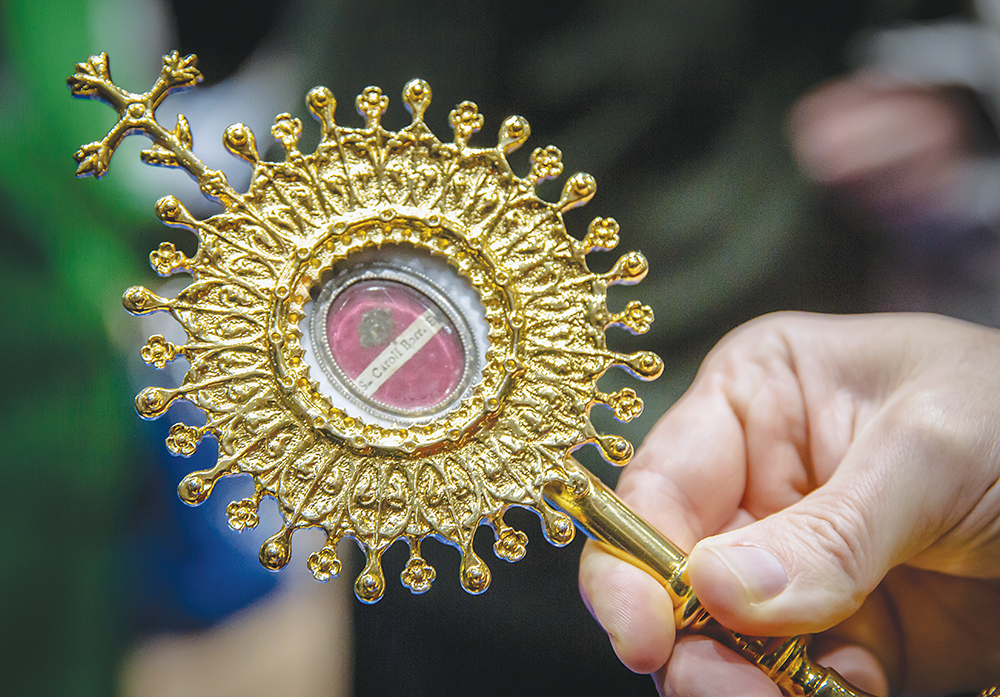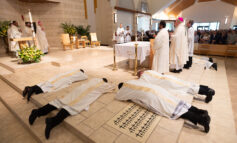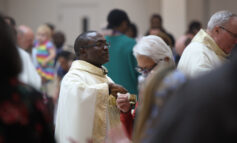
A man holds the relic of St. Charles Borromeo during the tour of Sacred Relics of the Saints at Mary Immaculate Catholic Church in Farmers Branch, Texas, Sunday, Jan. 13, 2019. (Ron Heflin)
By Father John Bayer
Special to The Texas Catholic
A few weeks ago, Mary Immaculate Catholic Church in Farmers Branch hosted “Treasures of the Church,” a traveling exhibition of sacred relics from the Vatican. By all appearances, it was a wonderful event.
Sacred relics are a profound element of Catholic piety. I have grown to love them, even if they can be somewhat provocative. I saw how relics can challenge people when I was studying in Rome and serving as a chaplain to hundreds of young American college students as they traveled abroad. Some thought it was just strange to venerate the remains of dead people. Many others were bewildered by the claims made about purported relics in churches and museums all over Europe. Needless to say, some of these claims are dubious, but others are made with real historical-critical scholarship. In any case, the relics often provoked strong reactions in the people I accompanied, as they did in me when I first wrestled with the reality.
Are relics weird? Are they important? Through my time in Rome, I came to the conclusion that relics really are a valuable part of Catholic tradition, because they belong to our humanity and to the richness of the Gospel.
Why do I say they belong to our humanity? Well, when my grandmother died, I asked my grandfather if I could have the crucifix she prayed before every day. Does it matter to me that this is the very same crucifix she prayed with? You bet. Something about the fact that this very crucifix was physically hers makes me feel connected to her and inspires me to pray. Maybe you hold onto something similar. It seems to me we risk erasing something of ourselves, something essential in our memory and identity, if we become too indifferent to the concrete material that makes up our lives as individuals and as the church.
Why do I think relics belong to the richness of the Gospel? Well, Christianity is not about pure ideas but about a full-blooded reality: God entering the world in the Incarnation of his Word – and then staying there, never abandoning his flock through time. To find Christ, it is, of course, important to search with the intellect; but we will miss him entirely if we remain locked up in our ideas and so ignore him in the flesh and blood of history: in the poor, the saints, the sacraments and the apostolic church. History matters. Matter matters. If God embraces his material Church, shouldn’t we do so as well? And thus from the earliest times Christians held close to themselves the bodies and artifacts of the saints and members of the church, those whose lives and work were so clearly touched by grace.
One of the most famous examples of this is the relics of St. Peter. Deep beneath St. Peter’s Basilica are the remains of an ancient tomb, on top of which Constantine built a basilica in honor of St. Peter after he had legalized Christianity. Early sources tell the story of St. Peter’s martyrdom in the Circus Caligula (or where St. Peter’s Square is today), and how the early Christians buried him in a necropolis just northwest of where he was killed (or where St. Peter’s Basilica is today). His grave became a pilgrimage destination, as ancient graffiti reveals. In the second century, Pope Anicetus had marked the pilgrimage spot with a tropaion or memorial. Constantine’s builders, in order to secure the basilica, filled in the necropolis and aligned the floor such that the altar would be on top of the old memorial. There his grave remained buried until archeologists in the twentieth century went digging.
If you want to hear the rest of the story, look up The Fisherman’s Tomb: The True Story of the Vatican’s Secret Search by John O’Neill. This fun book explains how George Strake, a Texas oilman, secretly funded for decades the Vatican’s effort to confirm whether the bones underneath St. Peter’s Basilica did in fact belong to St. Peter, as almost 2,000 years of tradition testifies. It also tells the story of Margherita Guarducci, an Italian epigraphist and archeologist, whose genius has given us the historically-critical evidence vindicating this tradition. And the next time you come across a relic, praise God for drawing so near to us, for filling our bodies and spirits with his grace: “For what great nation is there that has gods so close to it as the Lord, our God, is to us whenever we call upon him?” (Deuteronomy 4:7).
Father John Bayer, O.Cist., is a theologian and monk at the Cistercian Abbey of Our Lady of Dallas in Irving. His column appears occasionally in The Texas Catholic.



